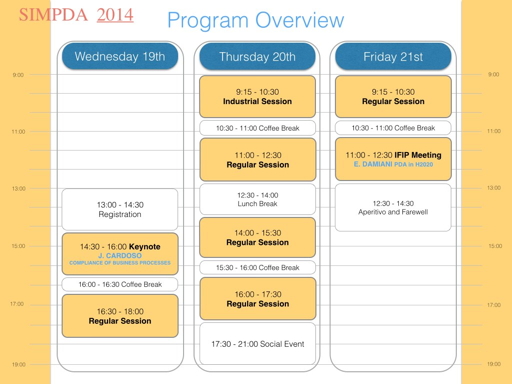Claudia Sebastiani
Creativi Quadrati, Partner openERP
Business Process Measurement in small enterprises after the installation of an ERP software
We report the observation of the first six months of operation after the installation of an ERP software in a group of small Italian enterprises (some dealers of various products and one manufacturer). Before the ERP, no explicit process descriptions existed within the companies: the operations were manually performed, using office automation software or legacy programs that were not process oriented. The new ERP is equipped with a workflow engine, a number of standard processes that should be followed by the users, and a tracking system that logs the main steps of the processes. We use process mining tools to analyze the events logged by the ERP during the sales, the purchases and the manufacture cycles. Our aim is to 1) compare the ideal processes suggested by the ERP with the real paths followed by the users 2) describe the eventual adaptation of these paths, as the users became acquainted with the ERP 3) highlight critical segments in terms of time spent, iterations, etc. 4) compare the processes of different companies that are in similar business areas. The final goal is to get a better understanding of the processes and a rationalization of the operations. It must be stressed that both the ERP and the main tools used are open source, so that the process measurement is affordable even for very small (micro) enterprises.
Gregorio Piccoli
Zucchetti
Hierarchical clustering for managers
Data Mining and Process Mining over big amount of data are today more and more requested by companies. However managers do not have the necessary competences for handling the results of analysis ran using these techniques. For this reason data visualization is a key element to exploit the full potential of data analysis. Zucchetti spa has developed an in-house approach for constructing user-friendly data visualizers.
Gabriele Ruffatti
Engineering Ingegneria Informatica
A living story: measuring quality of developments in a large industrial software factory with Open Source Software
Open Source has no more intrinsic value per se. Nowadays it is facing new challenges, such as stimulating creativity and bringing innovation into market. One of its major challenges consists in delivering valuable outcomes, which requires a PMAI approach: Plan metrics and dimensions of analysis, get Measures and global performance value from data, Assess results and Improve processes by solving issues and removing bottlenecks. Engineering Group uses Open Source Software to makes this happen. Spago4Q, the analytic of the business intelligence suite SpagoBI, allows the company to measure the quality of products, processes and services and to monitor the continuous improvement of quality practices. The measurement and enhancement of productivity complies with quality certifications such as ISO and CMMi standards. QESTnd - an n-dimensional measurement model - allows to collect performance values on three dimensions of analysis (Economical, Social and Technical) in order to identify process areas that need improvements. Drill-down capabilities provide both a unified view of the global performance of the Labs and detailed views of the single process dimensions.
Please, download the SIMPDA2014 detailed program here






